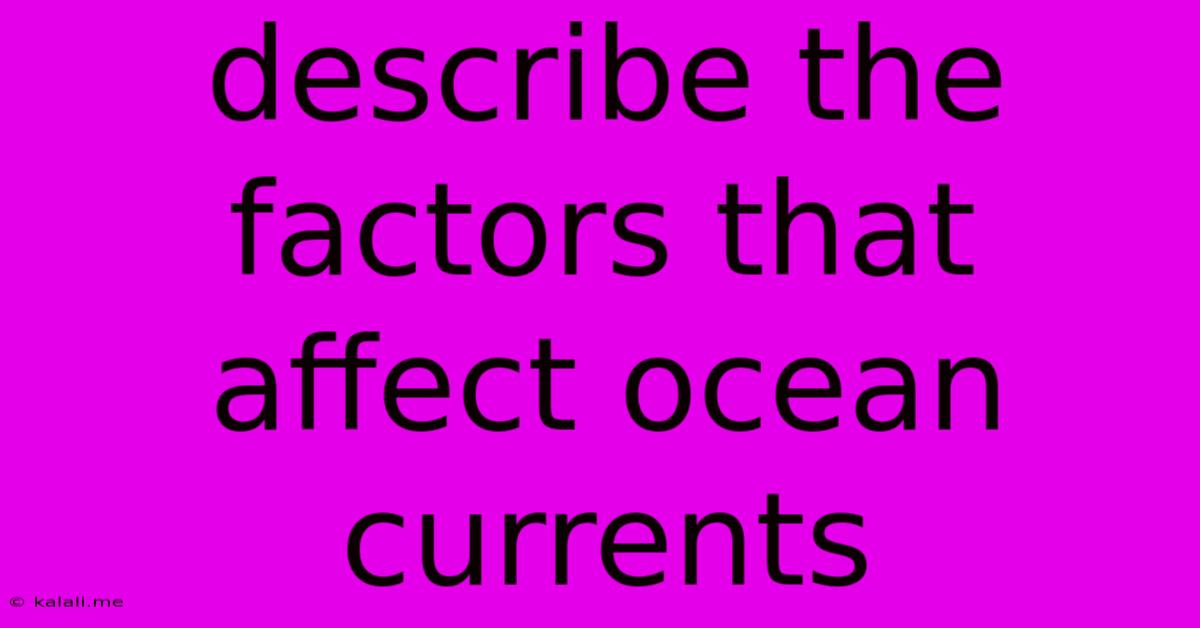Describe The Factors That Affect Ocean Currents
Kalali
May 10, 2025 · 4 min read

Table of Contents
Factors Affecting Ocean Currents: A Deep Dive
Ocean currents, the massive rivers of seawater flowing through the world's oceans, are vital for regulating Earth's climate, distributing nutrients, and shaping marine ecosystems. Understanding what drives these powerful currents is key to comprehending our planet's intricate systems. This article delves into the various factors influencing the formation, direction, and strength of ocean currents.
What are ocean currents and why are they important? Ocean currents are continuous, directed movements of seawater driven by a combination of forces. These massive flows of water significantly impact global climate patterns by distributing heat from the equator towards the poles. They also play a critical role in nutrient dispersal, supporting diverse marine life and influencing the distribution of various species. Understanding these currents is crucial for predicting weather patterns, understanding marine ecosystems, and assessing the impact of climate change.
1. Wind: The Primary Driver
Wind is arguably the most significant factor driving surface ocean currents. The consistent, large-scale wind patterns, like the trade winds and westerlies, exert a frictional force on the ocean's surface, dragging the water along. This is known as wind-driven circulation. The Coriolis effect, caused by Earth's rotation, further influences the direction of these currents, deflecting them to the right in the Northern Hemisphere and to the left in the Southern Hemisphere. This deflection creates the characteristic circular patterns, or gyres, observed in major ocean basins. Think of the powerful Gulf Stream, a major warm current largely influenced by prevailing winds.
2. Density Differences: Thermohaline Circulation
Beyond wind-driven currents, variations in water density play a crucial role in creating deep-ocean currents, a process known as thermohaline circulation or the "global conveyor belt." Density is determined by two primary factors: temperature (thermo) and salinity (haline). Colder, saltier water is denser and sinks, while warmer, less saline water rises. This density difference creates a continuous cycle of sinking and rising water masses, driving a slow but powerful global circulation system. The formation of sea ice in polar regions, for example, increases salinity in the surrounding water, causing it to become denser and sink, initiating a deep-water current.
3. The Earth's Rotation: The Coriolis Effect
The Earth's rotation exerts a significant influence on the direction of ocean currents. The Coriolis effect deflects moving objects, including water, to the right in the Northern Hemisphere and to the left in the Southern Hemisphere. This deflection is not apparent over short distances but becomes increasingly significant as the distance traveled increases. The Coriolis effect is responsible for the spiral shape of many ocean currents and the formation of large-scale gyres.
4. The Shape of Ocean Basins and Coastlines: Topographic Influences
The shape of ocean basins and coastlines significantly impacts the path and strength of ocean currents. Ocean floor topography, including underwater mountains and ridges, can deflect currents, causing them to split, merge, or accelerate. Similarly, continental margins and islands can act as barriers, forcing currents to change direction and influencing the formation of eddies and upwelling zones. These geographical features significantly shape the complex patterns we observe in ocean currents.
5. Tides: Gravitational Influence
Tidal forces, generated by the gravitational pull of the moon and the sun, also contribute to ocean currents, albeit on a smaller scale compared to wind and density differences. Tides create rhythmic fluctuations in sea level, influencing the speed and direction of near-shore currents. The interaction between tidal currents and other factors can create complex flow patterns, particularly in coastal regions and estuaries.
6. Salinity Variations: A Key Driver in Density
Changes in salinity directly impact water density, influencing thermohaline circulation. Salinity variations are caused by factors like evaporation (increasing salinity), precipitation (decreasing salinity), and river runoff (decreasing salinity). Areas with high evaporation rates, such as in subtropical regions, tend to have higher salinity and thus denser water, contributing to downwelling and deep-ocean currents.
In conclusion, ocean currents are a complex interplay of various factors. Wind, density differences, the Coriolis effect, the shape of ocean basins, tides, and salinity variations all contribute to the formation, direction, and strength of these crucial global features. Understanding these factors is vital for comprehending the intricate workings of our planet’s climate system and the health of its oceans.
Latest Posts
Latest Posts
-
What Is The Average Iq For A 5 Year Old
Jul 12, 2025
-
How Many 12 Oz Cups In A Gallon
Jul 12, 2025
-
How Much Older Is John The Baptist Than Jesus
Jul 12, 2025
-
How Many Teaspoons In A Pound Of Sugar
Jul 12, 2025
-
How Do You Pass Level 12 On Bloxorz
Jul 12, 2025
Related Post
Thank you for visiting our website which covers about Describe The Factors That Affect Ocean Currents . We hope the information provided has been useful to you. Feel free to contact us if you have any questions or need further assistance. See you next time and don't miss to bookmark.